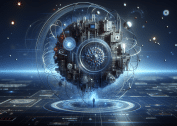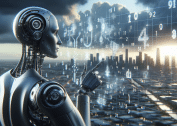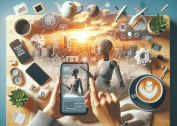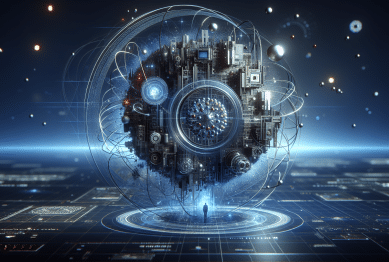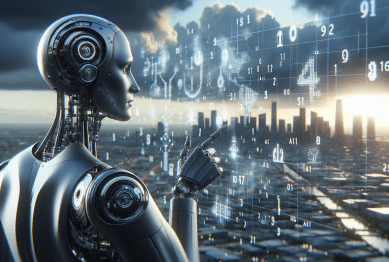Explore how artificial intelligence is shaping daily tasks and revolutionizing modern work environments. From smart automation to enhanced online security, discover ways AI tech makes life more efficient while keeping data safe.
The Rise of Artificial Intelligence in Daily Life
Artificial intelligence now powers many aspects of everyday living, often without being noticed. Virtual assistants, such as those built into smartphones or used in smart homes, demonstrate how AI streamlines repetitive actions. These assistants can manage schedules, set reminders, and even control household appliances with simple voice commands. Over the last decade, machine learning algorithms have quietly optimized everything from online shopping experiences to map navigation tools. Even basic search engine queries harness AI to deliver accurate, personalized results. Artificial intelligence technologies are being woven deeper into the fabric of daily routines, creating subtle but impactful changes in the way people interact with digital systems.
The popularity of AI innovations has driven businesses and individuals to seek advanced solutions for workflow improvement. Chatbots, for example, provide real-time responses to customer inquiries, reducing wait times and improving satisfaction. Smart filtering systems automatically sort through emails and prioritize tasks, clearing clutter and reducing missed deadlines. The convenience of these smart tools means more people can focus their time and abilities on creative and strategic activities. This progressive shift enables efficiency not only in professional environments but also in personal life management, underscoring the influential role of artificial intelligence in shaping modern routines.
AI’s expansion into daily operations raises interesting questions about human reliance on intelligent systems. As automation expands, the need for digital skills grows as people learn to collaborate with software designed to handle mundane responsibilities. With each update and innovation, AI becomes more accessible and user-friendly. This widespread integration is making advanced tech feel less intimidating and more relevant to non-technical users. For those willing to explore, AI opens doors to novel approaches for organizing, communicating, and solving problems in personal and professional realms.
AI-Powered Collaboration and Productivity Tools
Artificial intelligence has led to the development of powerful collaboration tools, reshaping how teams connect across locations. Cloud-based platforms incorporate intelligent scheduling, document versioning, and real-time translation, simplifying group communication. AI-driven project management software analyzes deadlines, assigns tasks, and flags potential obstacles before they become setbacks. These smart functions support global teamwork with fewer miscommunications and greater precision in shared goals. For organizations juggling complex projects and remote staff, such features have proven indispensable.
Automated note-taking apps, powered by natural language processing, now offer accurate transcription alongside actionable highlights during virtual meetings. These tools free participants to focus on discussions rather than manual recording. In parallel, smart email sorting, calendar syncing, and workflow automation further help streamline busy schedules. Such developments reduce error rates and help managers oversee teams more effectively, especially as hybrid work models become the norm. The resulting increase in organizational efficiency benefits both the workforce and the business itself.
Despite concerns about job automation, many workers have discovered that AI tools allow for more meaningful work. Routine and time-consuming tasks are now handled by intelligent assistants, freeing human creativity for high-level problem-solving or unique customer care. As organizations invest in AI productivity platforms, many employees receive training to maximize the effectiveness of these solutions. This partnership between human insight and machine speed is changing workplace culture, fostering an environment in which technology amplifies human strengths.
Smart Automation and Its Impact on Industries
Smart automation, powered by AI, is rapidly transforming sectors beyond technology, including healthcare, manufacturing, and finance. In healthcare, predictive algorithms assist doctors in diagnosing diseases earlier by analyzing medical records and imaging more accurately than manual review. Manufacturing plants use robotics for material handling, inspection, and packaging. In finance, intelligent systems sift through massive data volumes to detect fraud and offer personalized investment advice. This sector-wide adoption reflects AI’s ability to reduce errors, save money, and enhance service delivery.
Large organizations harness machine learning tools for supply chain optimization, allowing for real-time response to fluctuations in demand or logistics interruptions. Automated systems can flag abnormal patterns that may indicate underlying process inefficiencies. The ability to predict maintenance needs, for example, helps keep critical machinery running smoothly while reducing costly downtime. This integration of predictive intelligence makes businesses more agile and ready to compete in ever-changing markets.
The ripple effects of automation extend to small and medium enterprises as well. Affordable AI solutions tailored for small businesses help with inventory tracking, customer relationship management, and targeted marketing campaigns. These technologies level the playing field, giving companies with limited resources a chance to innovate and excel. As automation matures, attention is shifting toward reskilling workforces and reimagining traditional job roles, ensuring a sustainable balance between human talent and digital advancement.
Enhancing Online Security with AI
With rising digital threats, artificial intelligence has become indispensable for protecting personal and corporate data. AI-powered cybersecurity systems constantly monitor network traffic for suspicious activities, flagging and containing potential breaches before they escalate. Machine learning allows these tools to adapt to evolving threat landscapes, learning from each attack and updating defenses accordingly. This responsive defense strategy helps reduce the risks posed by phishing, ransomware, and malware attacks on sensitive information.
Advanced authentication processes leverage AI to ensure user access remains secure. Biometric verification, such as facial recognition and fingerprint scanning, is powered by algorithms that refine detection accuracy through experience. AI systems can spot subtle deviations in login behavior, quickly alerting users and administrators to potentially unauthorized access. These proactive measures protect sensitive accounts against hacking attempts and identity theft, providing peace of mind for both businesses and individuals.
Organizations facing compliance requirements, like those outlined in the General Data Protection Regulation (GDPR), benefit from AI solutions designed to oversee and enforce privacy policies at scale. Automated systems can track data flows, flag insecure practices, and help maintain detailed audit trails. This high level of oversight makes meeting international standards less burdensome and more precise. As data privacy demands increase, AI will continue to play a central role in enabling transparent, accountable security operations online.
AI in Everyday Devices and Consumer Tech
Consumer technology has leaped forward through AI integration in smart devices, turning traditional gadgets into intuitive companions. Voice-controlled speakers can adjust lighting, music, or thermostats based on simple voice requests. Wearable health trackers, using advanced data analysis, help users understand activity levels, sleep quality, and even potential health trends. These personal insights foster healthier routines, while the automation of daily tasks through connected applications creates a seamless living environment.
Smart cameras and security systems utilize facial recognition, motion detection, and real-time alerts to help safeguard homes. In entertainment, AI-driven recommendation engines curate playlists, movie suggestions, and tailored news feeds that suit personal tastes. Even kitchen appliances, such as refrigerators and coffee makers, are being outfitted with predictive maintenance systems and recipe-suggestion features. Each upgrade brings more convenience and personalization into daily routines, highlighting the value of intelligent consumer technology.
Beyond convenience, AI-embedded devices are improving accessibility for people with disabilities. Text-to-speech readers, real-time language translation, and navigation aids empower greater independence in everyday life. Many of these products continue to evolve through user feedback and ongoing machine learning improvement. As developers look for ways to increase user satisfaction and reach broader audiences, AI promises to remain at the heart of next-generation consumer tech innovation.
The Future of Artificial Intelligence: Trends to Watch
Current trends in artificial intelligence suggest rapid evolution across industries and daily life. Advances in explainable AI help demystify complex decision-making processes, making systems more transparent for users and tech professionals alike. Autonomous systems, like self-driving vehicles and delivery drones, are entering mainstream scenarios with growing reliability. These advancements highlight the trend toward greater trust and practical application of AI in routine environments.
As AI models grow more sophisticated, focus is turning to ethical implications and responsible development frameworks. Initiatives from global organizations stress the need for fairness, inclusion, and accountability in deploying AI applications. Research into bias reduction, algorithm transparency, and community involvement is helping shape standards that protect user interests. The intersection of ethical design and technological advancement is likely to become central in future discussions around AI growth.
Future adoption of artificial intelligence will likely emphasize hybrid intelligence—humans collaborating seamlessly with machines. This approach promises to unlock untapped innovation and productivity, with AI enhancing creativity, learning, and problem-solving in previously unimaginable ways. By staying informed about emerging trends and digital skills, individuals and organizations can harness AI’s growing potential for a smarter, more secure, and equitable world.
References
1. European Commission. (2023). Artificial Intelligence. Retrieved from https://digital-strategy.ec.europa.eu/en/policies/artificial-intelligence
2. National Institute of Standards and Technology. (2023). Artificial Intelligence. Retrieved from https://www.nist.gov/artificial-intelligence
3. U.S. Department of Energy. (2022). The Role of Artificial Intelligence in Achieving Energy Justice. Retrieved from https://www.energy.gov/diversity/articles/role-artificial-intelligence-achieving-energy-justice
4. Future of Life Institute. (2023). AI Policy. Retrieved from https://futureoflife.org/ai-policy/
5. Harvard University. (2022). Artificial Intelligence in Daily Life. Retrieved from https://sitn.hms.harvard.edu/flash/2022/artificial-intelligence-in-daily-life/
6. Brookings Institution. (2023). The Rise of Artificial Intelligence: Opportunities and Challenges. Retrieved from https://www.brookings.edu/articles/the-rise-of-artificial-intelligence-opportunities-and-challenges/



